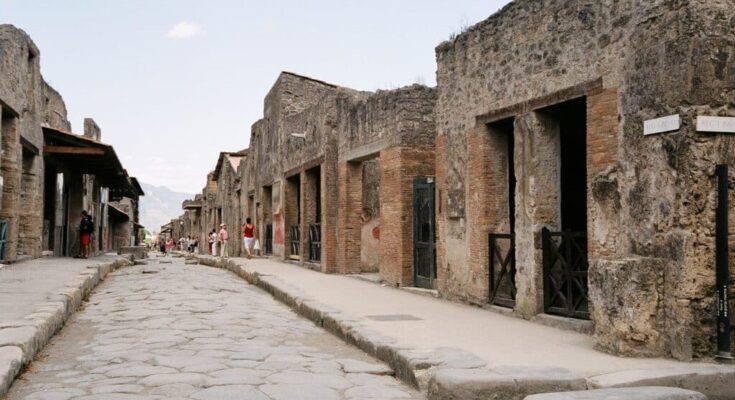
Archaeologists have uncovered a well-preserved house in ancient Pompeii, featuring frescoes depicting scenes from Greek and Roman mythology.
The dwelling, named the “House of Phaedra,” has remained untouched since Mount Vesuvius’ devastating eruption almost 2,000 years ago. This small home offers a striking glimpse into ancient art and architectural changes during the first century AD.
Phaedra, the wife of Theseus, the Athenian king who famously defeated the Minotaur, becomes infatuated with her stepson, Hippolytus. Her love, unreciprocated and scandalous, ultimately leads to her demise, embodying the Greek tragedies that delve into complex emotions, fate, and the human condition.
The depiction of Phaedra and Hippolytus on the walls of this Pompeian home reflects the Romans’ deep admiration for Greek tales and their penchant for blending myth with daily life.

Frescoes at Pompeii on themes of love from Greek mythology
Other frescoes in the House of Phaedra capture a sensual scene between a satyr and a nymph—a frequent motif symbolizing the wild, uninhibited forces of nature in Greek and Roman mythology.
Another painting depicts what archaeologists believe to be Venus and Adonis, echoing themes of love, beauty, and fate that resonate throughout mythological lore.

The building also boasts numerous smaller, but detailed and beautifully preserved patterns and scenes from nature.
The House of Phaedra sheds light on changing architectural styles in the first century AD, the Pompeii archaeological park said in a statement.
Unlike many of the houses excavated at the site, it was not built around the traditional Roman atrium, an open space with a pool for collecting rainwater.
Despite its small size, the house “strikes us for the high level of its wall decorations,” the statement said, noting they were of similar quality to much larger and more opulent homes near the new discovery, which lies in the center of the site.
The once-thriving city of Pompeii and the surrounding countryside in southern Italy was submerged by volcanic ash when Mount Vesuvius exploded in 79 AD.
The eruption killed thousands of Romans who had no idea they were living in the shadow of one of Europe’s biggest volcanoes. It buried the city in a thick layer of ash, preserving many of its residents and buildings.
Greek culture thrived in Pompeii
The new finds come months after a stunning fresco of Helen of Troy and several other impressive artworks depicting scenes from Greek mythology were discovered at a house along Via di Nola, another street in Pompeii.

Archaeologists said the frescos are among the finest to be found in the ruins of the ancient site. Mythical Greek figures such as Helen of Troy are depicted on the high black walls of a large banqueting hall.
In 2019, Italian authorities unveiled an ancient fresco depicting a famous Greek myth in Pompeii to the public.
The fresco depicts the ancient Greek myth of Leda and the Swan. This is an erotic myth in which the god Zeus, in the form of a swan, seduces (or, according to other variations of the tale, rapes) Leda, the Aetolian princess who later became Queen of Sparta.
Pompeii, located in Campania in southern Italy, is an open-air museum where visitors can easily view the shockingly vivid remnants of the complete devastation of the city after the violent volcanic eruption.



